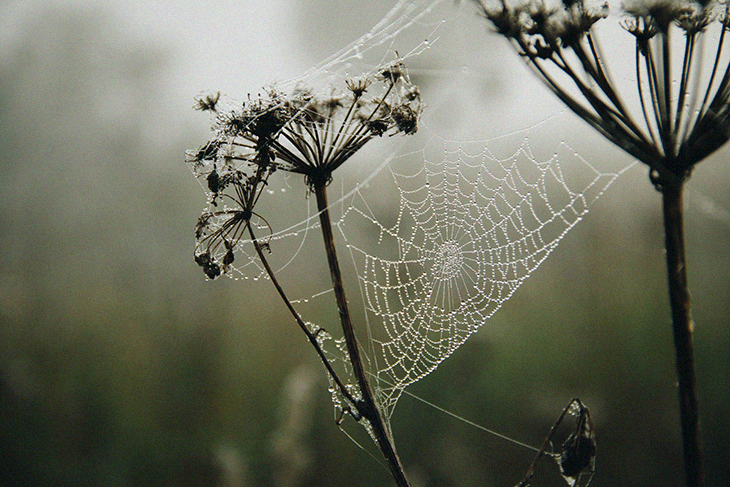
Unless you have a major case of arachnophobia, then you won’t argue that spiders are really cool creatures. Not only do they feed on bugs like mosquitos, flies and other agricultural pests, more of their species are actually not harmful to humans, unlike what is commonly believed.
But moreover, these eight-legged fascinating creatures use their sense of touch to truly understand the world around them. In fact, they depend on their sense of touch in order to work their way around their environment. And while people think that all the hair they have sticking out from their tiny bodies and legs makes them extra creepy, it’s actually those tiny hairs and slits that they use to recognize the different types of vibrations going on in the world around them.
For spiders, these vibrations allow them to tell whether its prey, another spider, or even just a breeze that’s making their intricate web move, all from the vibrational clamor alone. In fact, every strand of their sophisticated web makes a different type of tone that only they can understand or decipher.
Scientists have been intrigued by spiders and their complex webs, and understandably so. And just some years back, working with artist Tomás Saraceno, a team of researchers decided to translate the three-dimensional structure of a spider’s web into music by creating an interactive musical instrument which they named Spider’s Canvas.
Since then, the team has managed to refine and rebuild on the work that was previously done, adding an interactive virtual reality element that allows people to not only enter the web, but interact with it.
According to the research team, this will both help them get a better understanding of the architecture and build of a spider’s three-dimensional web, as well as aid in grasping a deeper knowledge and awareness of the vibrational language that spiders use.
Engineer Markus Buehler from the Massachusetts Institute of Technology, better known as MIT, explains “The spider lives in an environment of vibrating strings. They don’t see very well, so they sense their world through vibrations, which have different frequencies.”
When most people think or imagine a spider’s web, they normally imagine what looks like a flat, round weave with radial spokes all around it, which the spider then intertwines his spiral net around. But in reality, most spiderwebs are not built this way but actually in three dimensions – ‘like sheet webs, tangle webs, and funnel webs.’
In order to fully explore these different kinds of web structures, the research group took a Cyrtophora citricola spider, otherwise known as a tropical tent-web spider, and placed it inside a rectangular enclosure. They waited for it to fill up the area with its three-dimensional web, after which they took a sheet laser to light it up, creating high-definition images of its 2D cross-sections of the spider’s web.
The scientists then developed an algorithm, then put together the 3D architecture of the web using the 2D cross sections. In order to turn the web into music, they had to choose different sound frequencies which they assigned to the various strands. Depending on the pattern of the web’s structure is how the musical notes were created.
Meanwhile, the research group also scanned a web as the spider was spinning it, making sure to translate each step of the web process into music. What they observed was the each note changed as the structure of the web changed too, allowing the listener to actually hear the differences of the process of the web construction. By recording the step-by-step process, it also allowed the scientists to get a clearer grasp of how spiders build their 3D webs without needing to use support structures, which is actually a skill that could be used in 3D printing as well.
Through Spider’s Canvas, people can actually hear spider music, which is incredible on its own. But with the virtual reality aspect, audiences are allowed to actually enter the web and play the strands themselves, which is an entirely new and amazing facet to the entire experience.
Buehler shares, “The virtual reality environment is really intriguing because your ears are going to pick up structural features that you might see but not immediately recognize.”
“By hearing it and seeing it at the same time, you can really start to understand the environment the spider lives in,” he adds.
Another feature of the virtual reality environment is that via the realistic web physics they’ve created, the scientists can understand what happens when they change or mess with the different portions of the web as well. When they stretch on strand, the tone in the music changes. When they break one, it can affect or change the strands that surround it. Through this study, the researchers can also figure out and appreciate the sophisticated architecture of a spider’s web, as well as the reason why they are created that way.
And what is even more amazing is that this work has managed to allow the research to team to create an algorithm where they can actually identify the spider web vibrations such as “web under construction,” “trapped prey,” and even “another spider has arrived with amorous intent.” Throughout their research, the team has said that this is basically how they are laying the foundation of ‘learning to speak spider – at least, tropical tent-web spider.’
Buehler explains, “Now we’re trying to generate synthetic signals to basically speak the language of the spider.”
He adds, “If we expose them to certain patterns of rhythms or vibrations, can we affect what they do, and can we begin to communicate with them? Those are really exciting ideas.” And admittedly, even if you aren’t a lover of spiders, there is no denying just how groundbreaking this has been.
For those interested to see more of what the team has doe, they presented their work during the spring meeting of the American Chemical Society, while their previous research was published back in 2018 in the Journal of the Royal Society Interface.
What are your thoughts? Please comment below and share this news!
True Activist / Report a typo


